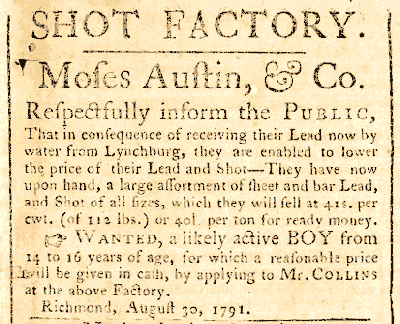Moses Austin's Lead
Today, Moses Austin, American lead, and -- at length -- Texas. The University of Houston's College of Engineering presents this series about the machines that make our civilization run, and the people whose ingenuity created them.
Meet Moses Austin, born into a Suffield, Connecticut, family in 1761 -- the youngest of eight children. His people were business folk. So, when Moses was 28, he and his brother saw opportunity in an abandoned lead mine in Virginia. The lead was there, and America needed it. The Austin brothers bought it, and they undertook what historian David Bracy calls "a feverish expansion."
They hired foreign experts at outlandish salaries. They built a new town around their mine and called it Austinville. They spent all they had, then hocked their homes. But it worked.
That was the beginning of the American lead industry. They put a lead roof on the Virginia Capitol building that Thomas Jefferson designed. They sold lead to New England and Kentucky.
Lead shot was one of their major products. In 1782 an English plumber invented the shot tower. He found that when you run molten lead through a sieve and let it fall into a water tank far below, surface tension forms the lead drops into almost perfect spheres. As early as 1790 the Virginia Chronicle reported that the Austins were making the first drop shot in America.
But their success wasn't all it seemed to be. The Capitol roof leaked. It had to be replaced with slate. And America kept right on importing most of its buckshot until just before the War of 1812. The Austins had built an industry, but they couldn't sustain it. They had to sell out. It was time to move on again.
So Moses left on a scouting trip to the west during the bitter winter of 1796. He dedicated a written account of that adventure to his young son, Stephen. He told him that America's fortunes lay west of the Mississippi. Then in 1798 he packed a wagon train and set out to create new lead mines in Missouri.
That venture lasted two decades and opened up lead sources far greater than those in Virginia. Then he made a really dumb move. Faced with a labor shortage in 1814, he turned to slaves. He was soon paying more to feed and house slaves than it would've cost to pay them as freemen. By 1819 he was bankrupt. It was time for a sick and aging Moses Austin to move on yet again.
So he went down into Texas. In San Antonio he struck a deal with the governor of the Spanish Province of Texas to admit settlers. He turned the course of American history, then went home to Herculaneum, Missouri, to die of pneumonia.
Of course his son Stephen F. Austin led the colonization of Texas. Today, the capital of Texas isn't named after Moses; it's named after Stephen. And Moses, his judgment not always as good as his vision, had to die without crossing over the Brazos River -- without finally entering this new land of promise.
I'm John Lienhard, at the University of Houston, where we're interested in the way inventive minds work.
(Theme music)
Gracy, D.B., II, Moses Austin: His Life. San Antonio: Trinity University Press, 1987.
I'm grateful to Andrea Bean Hough for digging up and providing all the source materials for this episode, and to Pat Bozeman for suggesting the topic -- both from UH Special Collections. Original Special Collections sources include American Mercury, Hartford, CT, August 2, 1790, pp. 1-2 (for a pickup of the Virginia Chronicle article about the Austinville mines). See also Shot Factory. Virginia Gazette & General Advertiser, Richmond, VA, August 30, 1791 (for an advertisement of the Austinville mines).
See Episode 422 for information about the invention of the shot tower.

Image courtesy of Special Collections, UH Library
1791 Richmond newspaper ad for Moses Austin's lead factory